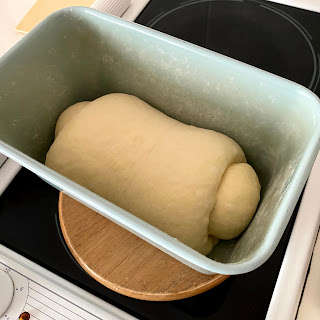I have quite a number of milk bread recipes, but most of them are sweet ones. Therefore, I tried a new recipe with a slightly saltier taste. The taste was good especially to go with salted butter.
As most of the ingredients used in this bread were unbleached, so the bread carried a sweet yellow hue in its crumb 🐤 And because of this golden tone from crust to crumb, I decided to rename it as Golden Milk Bread instead of Homemade Milk Bread 😃
Initially, I have no plan in preparing the recipe for my blog, as I wanted to taste the bread before recording the steps in photos. Due to a few requests from my FB readers, I have decided to upload a not-so complete recipe for this bread. Hope you would accept its crude form. I'll try to furnish with more complete photos after my next bake
I have uploaded the latest photos to the recipe. The bread was so easy to bake and delicious to eat, I have baked a total of 4 loaves within 2 weeks 😉
Serving: one loaf
Raw dough weight: 592g
Pan size: 1.5L, 21x13x10 cm
Baking temperature: Preheat oven to 190℃, bake at lower rack at 180℃ for 15 minutes, reduce to 170℃ for about 20 minutes.
Ingredients
250g unbleached bread flour
30g Prima Plain Flour plus/plain flour
30g raw sugar
3g instant dry yeast +
50g natural yeast, 100% hydration *
15g beaten egg
150g cold lactose-free milk/milk
10g evaporated milk/fresh milk
25g cold water, to be added depending on dough moisture
4g low-sodium fine salt
30g unsalted butter, softened
+ as I was in a hurry, so I added 3g of instant dry yeast instead of the 2g I would usually use.
* 50g of natural yeast can be replaced by 25g of bread flour and water each.
For a more detailed steps in preparing the dough and shaping method, you may browse another of my simlar recipe at Honey & egg Bread.
Directions:
1. Mix all the dry ingredients in a big mixing bowl,
then followed by the wet ingredients, except the salt and softened butter.
Combine into a ball, cover with a lid and let it undergoes autolysis for about 15 to 20 minutes.
Knead using a hand mixer fitted with a pair of dough hooks at low speed for about 2 to 3 minutes. Add in the salt and knead for about 1 minute.
Mix in the softened butter, and knead till the dough becomes less sticky.
Wear a glove to perform about 300 ~ 500 sets of "slapping and folding" till reaching window pane.
 |
| window pane stage |
2. Shape the dough into a ball. Spray some water over, cover with a lid and let it proof for about 60 minutes.
3. Turn out the dough onto a floured work top. Deflate the dough, and shape into a ball, cover and let it rest for about 15 minutes.
4. Roll out the dough to about 1cm thick.
Fold in the two wings towards the middle.
Roll flat slightly, and roll up, pinch to seal the end.
Place the shaped dough into a loaf pan lightly coated with butter. Spray some water, cover with a tea cloth, and let it undergo second proofing for about 45 minutes, or till the dough rises to almost the rim of the pan.
7. Slice the bread after it has completely cooled down. Enjoy 😋

































Good morning, Ngai Leng! When you say *50g of natural yeast can be replaced by 25g of bread flour and water each * <---- I just want to double check that it means 25g of bread flour and 25g of water respectively, is that right? Thank you in advance :)
ReplyDeleteHi Ann-Gee, so sorry for my late reply. You are correct with the interpretation ;)
Delete
ReplyDeleteAbsolutely love the soft texture and rich flavor of Fresshrise's Premium White Bread! It's my go-to choice for sandwiches, toast, or simply enjoying with a smear of butter. Fresshrise never disappoints when it comes to quality and taste.